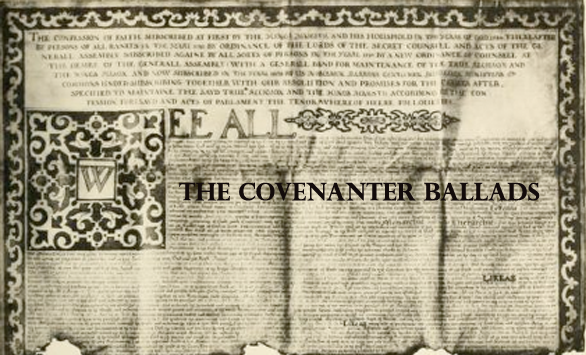Lesly’s March
Scott incorrectly states that Ramsay had previously published the song in The Ever-Green, when it was actually published in Vol II of his Tea-Table Miscellany.The error is not corrected from the 1803 edition, and it is reprinted in the 3rd, 4th and 5th editions. Ramsay entitled the piece “General Lesly’s March to Longmarston Moor”.
Scott presents the song without any verse definition, in the same manner as Ramsay. Joseph Ritson also published the song, with music, in volume II of his Scotish Songs.
History
This is a propaganda piece in support of the Covenanting cause. The reference to “the true gospel” is that of the Presbyterians, rather than the Book of Common Prayer and the Book of Canons, which Charles I imposed on the Scottish Kirk, in an attempt to create a uniformity between the Kirk and the Anglican Church. This, it was felt by many, was an attempt to reduce Presbyterianism and would help Catholicism regain a dominant foothold: Charles’ Queen, Henrietta Maria, was Catholic, and it was feared she had a deal too much influence over her husband.
This piece is relentlessly partizan, and, as with most of this type of song, it offers no quarter to the opposing sets of belief. It is disparaging of the Anglican and Catholic faiths and promotes the Covenanting beliefs as the only, true religion:
This “true gospel” is reiterated in the lines:
The parliament’s blythe to se us a’ coming:
When to the kirk we come,
We’ll purge it ilka room,
Frae popish reliques, and a’ sic innovation,
That a’ the warld may see,
There’s nane in the right but we,
Of the auld Scottish nation.
Characters
There were two individuals who were prominent in the Covenanting Cause with the surname Lesly or Leslie: Alexander Leslie, later Lord Leven, and David Lesly were both primarily professional soldiers, who joined the cause, rather than religious men who were put in charge of armed men. At the time of the Battle of Marston Moor, Alexander Leslie was lord general of the Army of the Covenant, while David Leslie was lieutentant general of the same army. It is presumed that the song is in honour of Alexander Leslie.
Alexander Leslie (c. 1580-1661)
Alexander Leslie was an illegitimate son of George Leslie, Captain of Blair Castle. After the death of his wife, George Leslie married the mother of Alexander, legitimising him. As a young man, he enlisted as a soldier, fighting firstly under Sir Horace Vere in the Netherlands (1605-7), then, having transferred to the Swedish army, under the monarchs Charles IX and Gustavus Adolphus. Under Gustavus Adolphus, Leslie rose to the rank of lieutenant-general and was knight by the Swedish monarch.
His Scottish campaigns began in 1638, when he returned to Scotland in response to the needs of the Covenanters. By this time Gustavus was dead, but Leslie, under the Swedish Queen Christina, had now gained the rank of field marshal, as noted in John Spalding’s Memorialls of the Trubles in Scotland and in England AD 1624-1645:
Now about this tyme, or a litle befoir, thair cam out of Germany fra the warrs, home to Scotland, ane gentleman of bass birth borne on Balveny, who had servit long and fortunatly in the Germane warris, and callit to his name Felt Marshall Leslie his Excellence. His name indeid wes [Alexander] Leslie, bot his valour and good luk attaned to this title his Excellens, inferior to none bot to the King of Swaden, wnder whome he servit amongis all his cavallierie.
Leslie drilled local men and also brought over Presbyterian veterans of his Swedish campaigns, as well as organising ammunition:
He began to dreill the Erllis men in Fyf; he casusit send to Holland for ammvnitioun, pulder and ball, in grete aboundans ; for mvskat, carrabin, pistoll, pik, suord, cannon, cartow, and all vther sort of necessar armes fir for old and younf solderis. He causit send to Germanye, France, Holland, Denmark, and vther countreis, for the most expert and valiant capitanes, livetennantis, and wnder officiares, who cam in gryte numberis vpone the hope of bloodie war.
He was an effective commander, and in an attempt to win him over to the Royalist side, Charles I bestowed the titles Earl of Leven and Lord Balgonie upon him 1641. However, he remained on the Covenanting side, leading the army into England, but deserting the field at Marston Moor, when he thought that the day was lost. It was Alexander Leslie, who supervised the captured King Charles I, until he was handed over to the English Parliament (1647).
He was appointed commander of all forces raised in the defence of Scotland. He tried to resign from the post in 1650, an elderly man exhausted by his military life, but the Scottish Parliament, aware of an imminent threat of invasion from England, refused to accept. He was technically in command of the army which was defeated by Cromwell at Dunbar. Although David Lelsy had effective command. Alexander Lesly accepted overall responsibility for the the defeat, but was exonerated by the Scottish Parliament, which yet again refused to accept his resignation. He found himself a prisoner of English troops in 1651 and remained in captivity until 1654, whereupon he finally returned to his estates, and died in April 1661.
Marston Moor information: http://www.battlefieldstrust.com/resource-centre/medieval/battleview.asp?BattleFieldId=24
Order of Battle: http://www.british-civil-wars.co.uk/military/oob-marston-moor.htm
